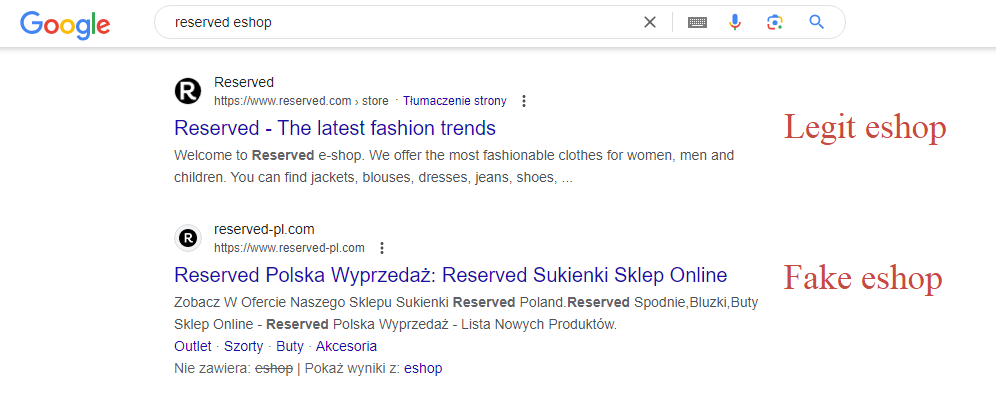We kicked off the holiday shopping season with expectations of sales, but beware: a new wave of fake e-shops is spreading on the internet.
Need to do some last-minute shopping for the holidays? Found a cool shop with great deals? Check it once, check it twice. Make sure you’re buying from a legitimate online store.
Our experts have noticed increased activity from cybercriminals who are taking advantage of the festive frenzy, identifying over 80,000 fake e-shops. These counterfeit sites are designed to mimic trusted brands. The goal is to scam unsuspecting shoppers into sharing personal and financial information and purchasing counterfeit goods—that is, if the items ever show up.
The fake e-shop setup
These counterfeit websites are made to look and feel like legitimate stores. That includes using similar URLs to confuse shoppers. Examples include:
- amaznboxsaleus.com
- balenciaga-outletstore.com
- thenorthface-us.com
- b-bestbuy.com
The holiday season is more like hunting season for scammers, who exploit the increase in online shopping driven by holiday sales and post-holiday deals. With the rush to grab bargains, online shoppers need to stay aware of the risks lurking online.
How fake e-shops steal your identity and money
The scammers' strategy is straightforward yet effective: target popular brands known for their holiday sales. They meticulously replicate everything from product offerings to website design, creating a convincingly authentic shopping experience.
This high level of detail in imitation makes it particularly challenging for shoppers to discern the real from the fake, especially when in pursuit of good deals on clothing, footwear, and other popular items.
But fret not! Let’s get in the details of the scam to help you identify it.
Stage 1: Info request
It usually begins with a request for personal information during a fake login or purchasing process. You might stumble upon these fake e-shops at the top of a Google or Bing search, where they present themselves with credible-looking domains, often using common TLDs like .com or .co. Their websites appear professional and are usually grammatically correct, making typosquatting and blatant mistakes a rarity.

Once you click on a phishing link, a well-designed page opens up. One of the first red flags is the absence of a cookie popup, which is a standard feature on legitimate sites. Despite this, you can browse the page, view product categories, and scroll through items without any issue.

Stage 2: Sign-up required
As you engage with the site, more signs of deceit surface. When you try to add an item to the cart, a sign-in popup appears, compelling you to either log in with existing credentials or register a new account. This step is crucial for the scammer, as it's where you unknowingly send sensitive information—including usernames and passwords—directly to the attacker.
Stage 3: The irresistible deal
Once logged in, you can add items to your cart and proceed to checkout. Here, the scam often includes an additional discount, a tactic designed to make the deal look irresistibly attractive and rush you into making a decision.
Stage 4: Cashing in
The final stage of the scam is the most dangerous. It involves filling out payment information. This step requires entering sensitive details like your card number, CVV, or even PayPal credentials.
It's a comprehensive data harvest, capturing everything the scammer needs: your name, address, phone number, email, and credit card information. By the time you realize something is amiss, the attacker may already have all they need to misuse your personal and financial details.
How to stay safe when shopping online
Amidst the holiday shopping season, it’s crucial to be extra cautious and verify any e-commerce sites before making purchases. Here are some tips to help you shop safely:
- Verify the credibility of websites. Before entering personal information or making a payment, verify the credibility of the website. Check the URL, look for reviews from other customers, and ensure that the site is secured with “https.”
- Use trusted payment methods. Opt for trusted payment methods that provide an additional layer of protection for your financial details. Be cautious if there is only one payment method, especially if it requires entering your card details directly on the e-shop page. Legitimate platforms usually offer a variety of secure payment options.
- Be cautious during sales periods. While discounts are enticing, be cautious during purchases at sale prices. Resist the pressure for a quick buy without thorough consideration and comparison of offers.
- Watch out for signs of Observe warning signs such as spelling errors on websites, unusual email addresses, or suspicious offers. Legitimate e-shops often present themselves with care and professionalism.
- Keep your security software updated. Ensure that your computer or mobile device has up-to-date antivirus and antimalware software. This can protect your sensitive information from online threats.
- Report scams. Contribute to creating a safer online environment by reporting any suspicious websites to authorities, such as the FTC.
Help protect yourself from scammers this holiday season
Staying alert and informed is key to avoiding the pitfalls of holiday online shopping scams. By being aware of the tactics used by scammers and practicing safe online habits, you can enjoy the benefits of holiday shopping without the stress of falling for a scam.
So, keep these things in mind when looking for the pending gifts on your wish list. Happy, secure shopping this season!